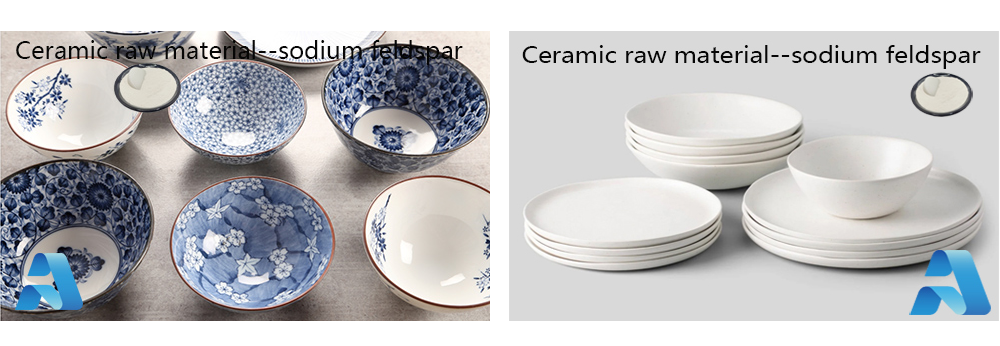
Sodium feldspar (chemical formula: NaAlSi3O8), as the most common mineral in the earth’s crust, has a unique crystal structure and chemical composition, making it an indispensable raw material in ceramic manufacturing. Sodium Feldspar not only has multiple functions such as fluxing, stabilization, and transparency, but also in the preparation process of ceramics, its excellent physical and chemical properties can significantly affect the quality and performance of ceramic products. The specific applications of sodium feldspar in ceramic raw materials and its significant advantages will be discussed in detail below.

Specific application of sodium feldspar in ceramics
Lower firing temperature and save energy
As a flux in ceramic glazes and green bodies, sodium feldspar can significantly reduce the firing temperature of ceramics. At high temperatures, sodium feldspar quickly decomposes and reacts with raw materials such as quartz and clay to form a glass phase, which helps reduce energy consumption while increasing the output of ceramic products. In addition, lowering the firing temperature can also reduce the gas escape from the green body, thereby reducing the formation of bubbles and defects and improving the overall quality of the product.
Enhance ceramic stability
Sodium feldspar fills the gaps between particles in the ceramic body to form a compact structure, which helps to enhance the mechanical strength, hardness and wear resistance of the ceramic. At the same time, sodium feldspar can also improve the thermal shock resistance of ceramics, making them stable in high temperature environments. In addition, sodium feldspar can reduce the water absorption rate of ceramics, thereby improving the weather resistance and service life of the product.
Improve ceramic translucency
Sodium feldspar is able to dissolve other minerals, such as kaolinite and quartz, facilitating the even distribution of glazes during firing. This uniformity not only improves the translucency of ceramic products, but also enhances the gloss and beauty of the glaze. For ceramic products that require transparent or translucent effects, such as lamps, tableware, etc., the addition of sodium feldspar is particularly important.
Optimize glaze texture
The addition of sodium feldspar can improve the fluidity of the glaze and make the glaze surface smoother and more delicate. Good fluidity helps the glaze to be evenly distributed on the surface of the body, reducing the formation of bubbles and defects. In addition, sodium feldspar can improve the hardness and wear resistance of the glaze, making ceramic products more durable during use.
Promote green body densification
During the firing process, sodium feldspar acts as a flux and fills the gaps between the green body particles, promoting the densification of the green body. The dense green body structure helps to improve the mechanical properties and chemical stability of ceramic products. At the same time, the addition of sodium feldspar can also improve the corrosion resistance of ceramics, allowing them to be used for a long time in harsh environments.
Analysis of the advantages of sodium feldspar in ceramics
Resource-rich and cost-effective
Sodium feldspar is widely distributed in the earth’s crust and has abundant reserves. This makes sodium feldspar one of the more cost-effective raw materials for ceramic production. At the same time, the mining and processing of sodium feldspar is relatively simple, which helps to reduce production costs and improve the market competitiveness of ceramic products.
Environmental protection and energy saving
As a flux, sodium feldspar can significantly reduce the firing temperature of ceramics, thereby reducing energy consumption and carbon emissions. This feature is in line with the green and low-carbon production concept currently advocated globally. In addition, the addition of sodium feldspar can reduce waste generation in the ceramic production process and reduce the impact on the environment.
Superior performance and wide applicability
Sodium feldspar has significant advantages in improving the mechanical strength, translucency, and glaze texture of ceramic products. The improvement of these properties makes ceramic products more widely used in fields such as building ceramics, sanitary ceramics, daily-use ceramics, etc. At the same time, sodium feldspar can also be used in combination with a variety of ceramic raw materials to adapt to different production processes and formulation requirements.
Promote technological innovation and industrial upgrading
With the continuous development of the ceramic industry and technological innovation, the application areas of sodium feldspar are also constantly expanding. For example, in the fields of high-performance ceramics and functional ceramics, the research and application of sodium feldspar is becoming increasingly in-depth. This will help promote the upgrading and development of the ceramic industry and enhance the international competitiveness of my country’s ceramic products.
In summary, sodium feldspar as a ceramic raw material has multiple advantages such as lowering firing temperature, enhancing stability, improving translucency, optimizing glaze texture and promoting body densification. These advantages make sodium feldspar play an irreplaceable role in ceramic production. If you want to know more, please contact Henan Ankai New Materials Co., Ltd.

Whether you have questions or you would just like to say hello,Contact us!
Call Anytime:
+86 15837207537Send E-mail:
info@lsakminerals.comAddress:
Anyang City , Henan Province, China.